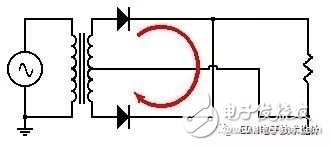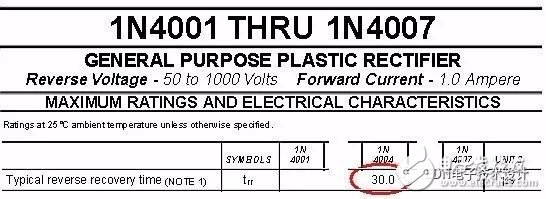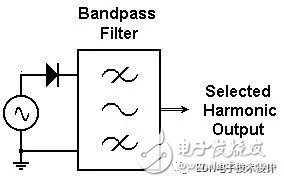The stored charge in a diode has traditionally been seen as an "enemy" in circuit design, but sometimes, if used wisely, it can actually become a "friend." Every type of diode exhibits a characteristic known as "storage charge," which plays a significant role during its operation. When a diode is conducting forward current, it doesn't stop instantly when the voltage is reversed. This behavior leads to various transient states that are worth exploring in detail.
The basic effect of stored charge is that when a reverse voltage is applied across the diode junction, it does not turn off immediately. Instead, a small amount of current continues to flow through the junction in the reverse direction for a short period. To clarify this concept, let's take a half-wave rectifier circuit as an example. In the ideal case, where the diode has no stored charge, the output waveform is clean and smooth, as shown below.
 Ideal diode half-wave rectification
So far, everything looks good. But what happens if the diode has stored charge? Let’s look at a slow recovery diode. As you can see, when the input sine wave crosses zero volts, the diode doesn’t turn off immediately. Instead, there's a brief but noticeable period of reverse conduction. Additionally, the transition to zero is very fast, which can lead to high-frequency harmonics—making EMI (electromagnetic interference) difficult to control.
Ideal diode half-wave rectification
So far, everything looks good. But what happens if the diode has stored charge? Let’s look at a slow recovery diode. As you can see, when the input sine wave crosses zero volts, the diode doesn’t turn off immediately. Instead, there's a brief but noticeable period of reverse conduction. Additionally, the transition to zero is very fast, which can lead to high-frequency harmonics—making EMI (electromagnetic interference) difficult to control.
 Slow recovery diode half-wave rectification
Even in full-wave rectifiers, we can observe reverse current pulses that may cause pulsed short circuits near the power source. These pulses can be quite severe, especially at line frequencies.
Slow recovery diode half-wave rectification
Even in full-wave rectifiers, we can observe reverse current pulses that may cause pulsed short circuits near the power source. These pulses can be quite severe, especially at line frequencies.
 Instantaneous short circuit
For instance, a typical 1N4007 diode has a nominal recovery time of around 30 microseconds. If the excitation frequency is 60 Hz, the half-period is about 8.33 milliseconds. The reverse conduction angle would then be roughly 0.648 degrees. At 120 V RMS, the voltage at this angle is approximately 1.92 V, enough to trigger unwanted short-circuit currents, as shown by the red arrow in the image.
Instantaneous short circuit
For instance, a typical 1N4007 diode has a nominal recovery time of around 30 microseconds. If the excitation frequency is 60 Hz, the half-period is about 8.33 milliseconds. The reverse conduction angle would then be roughly 0.648 degrees. At 120 V RMS, the voltage at this angle is approximately 1.92 V, enough to trigger unwanted short-circuit currents, as shown by the red arrow in the image.
 Slow diode recovery time
To address this issue, using a fast recovery diode is often recommended, even at low line frequencies. Fast recovery diodes significantly reduce these pulse effects, resulting in cleaner output waveforms.
Slow diode recovery time
To address this issue, using a fast recovery diode is often recommended, even at low line frequencies. Fast recovery diodes significantly reduce these pulse effects, resulting in cleaner output waveforms.
 Fast recovery diode half-wave rectification
In some applications, the stored charge isn’t always a problem—it can be useful. For example, when the excitation frequency increases into the HF, VHF, or UHF range, we can use a special component called a step recovery diode. This allows us to manipulate the stored charge to create a longer reverse conduction period, achieving a more controlled waveform.
Fast recovery diode half-wave rectification
In some applications, the stored charge isn’t always a problem—it can be useful. For example, when the excitation frequency increases into the HF, VHF, or UHF range, we can use a special component called a step recovery diode. This allows us to manipulate the stored charge to create a longer reverse conduction period, achieving a more controlled waveform.
 Step recovery diode half-wave rectification
This technique enables the generation of higher harmonic frequencies, which can be used in frequency multipliers. For instance, a 100 MHz input can be converted to 300 MHz output, making it a powerful tool in RF applications.
Step recovery diode half-wave rectification
This technique enables the generation of higher harmonic frequencies, which can be used in frequency multipliers. For instance, a 100 MHz input can be converted to 300 MHz output, making it a powerful tool in RF applications.
 Step recovery diode frequency multiplier circuit
Another interesting application involves high-frequency diodes like the PIN diode. At very high frequencies, the stored charge isn't fully depleted, and the PIN diode can be used as a variable attenuator. Its dynamic impedance changes with the applied current, allowing it to act as a controllable RF signal attenuator.
Step recovery diode frequency multiplier circuit
Another interesting application involves high-frequency diodes like the PIN diode. At very high frequencies, the stored charge isn't fully depleted, and the PIN diode can be used as a variable attenuator. Its dynamic impedance changes with the applied current, allowing it to act as a controllable RF signal attenuator.
 PIN diode signal attenuation component
PIN diode signal attenuation component
Make electronic design easy to get started, Zhang Fei takes you 5 weeks from entry to master hardware circuit design!
>> Click to learn the course
 Ideal diode half-wave rectification
So far, everything looks good. But what happens if the diode has stored charge? Let’s look at a slow recovery diode. As you can see, when the input sine wave crosses zero volts, the diode doesn’t turn off immediately. Instead, there's a brief but noticeable period of reverse conduction. Additionally, the transition to zero is very fast, which can lead to high-frequency harmonics—making EMI (electromagnetic interference) difficult to control.
Ideal diode half-wave rectification
So far, everything looks good. But what happens if the diode has stored charge? Let’s look at a slow recovery diode. As you can see, when the input sine wave crosses zero volts, the diode doesn’t turn off immediately. Instead, there's a brief but noticeable period of reverse conduction. Additionally, the transition to zero is very fast, which can lead to high-frequency harmonics—making EMI (electromagnetic interference) difficult to control.
 Slow recovery diode half-wave rectification
Even in full-wave rectifiers, we can observe reverse current pulses that may cause pulsed short circuits near the power source. These pulses can be quite severe, especially at line frequencies.
Slow recovery diode half-wave rectification
Even in full-wave rectifiers, we can observe reverse current pulses that may cause pulsed short circuits near the power source. These pulses can be quite severe, especially at line frequencies.
 Instantaneous short circuit
For instance, a typical 1N4007 diode has a nominal recovery time of around 30 microseconds. If the excitation frequency is 60 Hz, the half-period is about 8.33 milliseconds. The reverse conduction angle would then be roughly 0.648 degrees. At 120 V RMS, the voltage at this angle is approximately 1.92 V, enough to trigger unwanted short-circuit currents, as shown by the red arrow in the image.
Instantaneous short circuit
For instance, a typical 1N4007 diode has a nominal recovery time of around 30 microseconds. If the excitation frequency is 60 Hz, the half-period is about 8.33 milliseconds. The reverse conduction angle would then be roughly 0.648 degrees. At 120 V RMS, the voltage at this angle is approximately 1.92 V, enough to trigger unwanted short-circuit currents, as shown by the red arrow in the image.
 Slow diode recovery time
To address this issue, using a fast recovery diode is often recommended, even at low line frequencies. Fast recovery diodes significantly reduce these pulse effects, resulting in cleaner output waveforms.
Slow diode recovery time
To address this issue, using a fast recovery diode is often recommended, even at low line frequencies. Fast recovery diodes significantly reduce these pulse effects, resulting in cleaner output waveforms.
 Fast recovery diode half-wave rectification
In some applications, the stored charge isn’t always a problem—it can be useful. For example, when the excitation frequency increases into the HF, VHF, or UHF range, we can use a special component called a step recovery diode. This allows us to manipulate the stored charge to create a longer reverse conduction period, achieving a more controlled waveform.
Fast recovery diode half-wave rectification
In some applications, the stored charge isn’t always a problem—it can be useful. For example, when the excitation frequency increases into the HF, VHF, or UHF range, we can use a special component called a step recovery diode. This allows us to manipulate the stored charge to create a longer reverse conduction period, achieving a more controlled waveform.
 Step recovery diode half-wave rectification
This technique enables the generation of higher harmonic frequencies, which can be used in frequency multipliers. For instance, a 100 MHz input can be converted to 300 MHz output, making it a powerful tool in RF applications.
Step recovery diode half-wave rectification
This technique enables the generation of higher harmonic frequencies, which can be used in frequency multipliers. For instance, a 100 MHz input can be converted to 300 MHz output, making it a powerful tool in RF applications.
 Step recovery diode frequency multiplier circuit
Another interesting application involves high-frequency diodes like the PIN diode. At very high frequencies, the stored charge isn't fully depleted, and the PIN diode can be used as a variable attenuator. Its dynamic impedance changes with the applied current, allowing it to act as a controllable RF signal attenuator.
Step recovery diode frequency multiplier circuit
Another interesting application involves high-frequency diodes like the PIN diode. At very high frequencies, the stored charge isn't fully depleted, and the PIN diode can be used as a variable attenuator. Its dynamic impedance changes with the applied current, allowing it to act as a controllable RF signal attenuator.
 PIN diode signal attenuation component
PIN diode signal attenuation component
Make electronic design easy to get started, Zhang Fei takes you 5 weeks from entry to master hardware circuit design!
>> Click to learn the course
PP PE Rigid Plastic Pelletizing Line
Pp Pe Rigid Plastic Pelletizing Line,Pelletizing Line For Pp Pe Rigid Plastic,Pp Pe Rigid Plastic Pelletizing Machine,Pp Pe Rigid Plastic Pelletizing System
Zhejiang IET Intelligent Equipment Manufacturing Co.,Ltd , https://www.ietmachinery.com